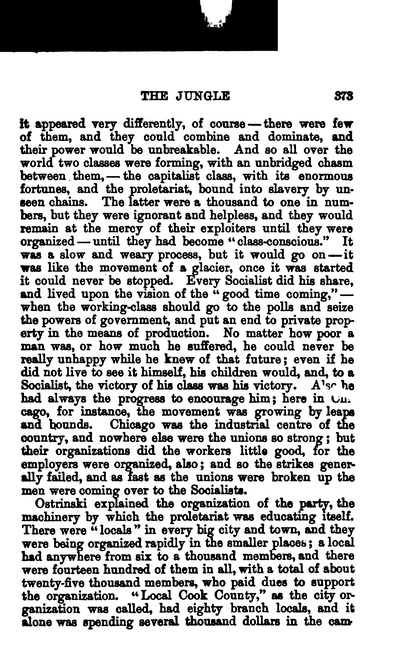 p372 _
-chap- _
toc-1 _
p373w _
toc-2 _
+chap+ _
p374
p372 _
-chap- _
toc-1 _
p373w _
toc-2 _
+chap+ _
p374
it appeared very differently, of course -- there were few
of them, and they could combine and dominate, and
their power would be unbreakable. And so all over the
world two classes were forming, with an unbridged chasm
between them, -- the capitalist class, with its enormous
fortunes, and the proletariat, bound into slavery by un~
seen chains. The latter were a thousand to one in num~
bers, but they were ignorant and helpless, and they would
remain at the mercy of their exploiters until they were
organized -- until they had become "class-conscious." It
was a slow and weary process, but it would go on -- it
was like the movement of a glacier, once it was started
it could never be stopped. Every Socialist did his share,
and lived upon the vision of the "good time coming," --
when the working-class should go to the polls and seize
the powers of government, and put an end to private prop~
erty in the means of production. No matter how poor a
man was, or how much he suffered, he could never be
really unhappy while he knew of that future; even if he
did not live to see it himself, his children would, and, to a
Socialist, the victory of his class was his victory. Also he
had always the progress to encourage him; here in Chi~
cago, for instance, the movement was growing by leaps
and bounds. Chicago was the industrial center of the
country, and nowhere else were the unions so strong; but
their organizations did the workers little good, for the
employers were organized, also; and so the strikes gener~
ally failed, and as fast as the unions were broken up the
men were coming over to the Socialists.
Ostrinski explained the organization of the party, the
machinery by which the proletariat was educating itself.
There were "locals" in every big city and town, and they
were being organized rapidly in the smaller places; a local
had anywhere from six to a thousand members, and there
were fourteen hundred of them in all, with a total of about
twenty-five thousand members, who paid dues to support
the organization. "Local Cook County," as the city or~
ganization was called, had eighty branch locals, and it
alone was spending several thousand dollars in the cam~
[[373]]
p372 _
-chap- _
toc-1 _
p373w _
toc-2 _
+chap+ _
p374